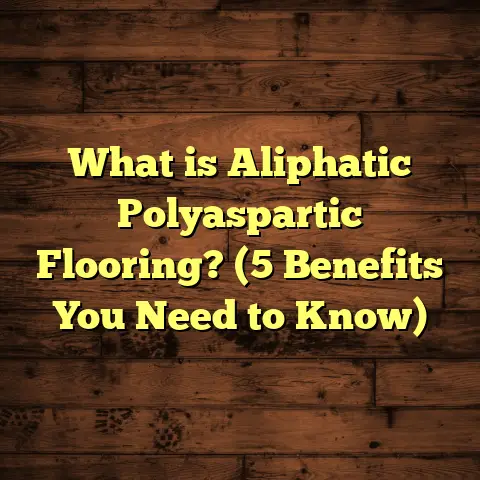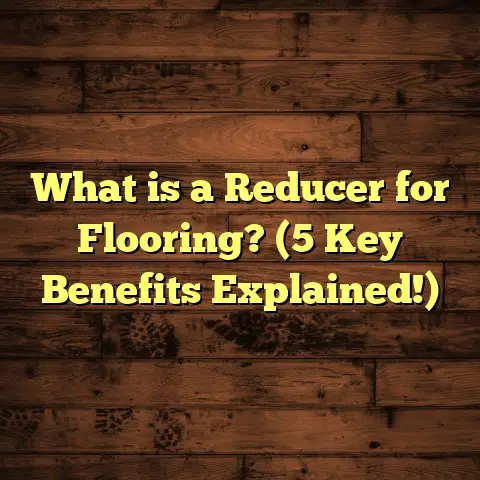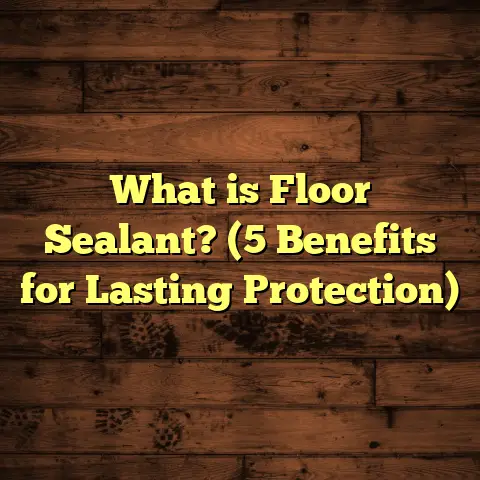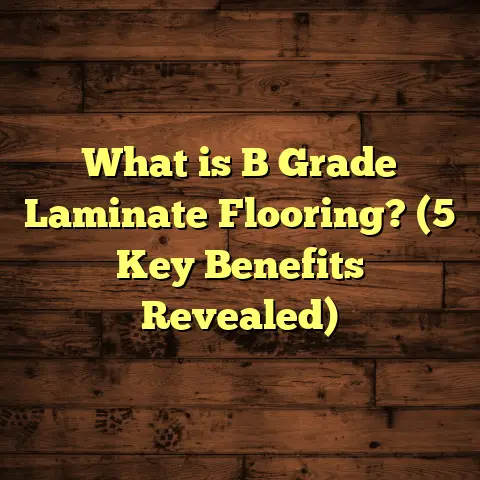What is Pre-Finished Hardwood Flooring? (5 Benefits You Need!)
I’m glad you’re interested in learning more about pre-finished hardwood flooring because there’s so much to unpack here. Over the years, I’ve helped homeowners, builders, and designers weigh the options between unfinished and pre-finished floors. I want to share everything I’ve learned—the good, the tricky parts, and everything in between.
Let’s start by revisiting the basics and then move through benefits, challenges, real-life stories from my projects, technical details, and practical advice that can help you make a confident decision for your flooring project.
What Is Pre-Finished Hardwood Flooring?
Pre-finished hardwood flooring is exactly what it sounds like: hardwood planks that come already finished from the factory. Unlike traditional unfinished hardwood—which requires sanding, staining, and sealing on-site—pre-finished floors are sanded smooth, stained (if desired), sealed, and coated with multiple layers of finish before they leave the factory.
How Does This Process Work?
At the manufacturing plant, the wood goes through several steps:
- Sanding: The boards are sanded by machines to create a perfectly smooth surface.
- Staining: If a color is desired, the wood is stained uniformly.
- Sealing and Finishing: Multiple coats of durable finish are applied. These finishes usually include polyurethane or aluminum oxide coatings. The boards are cured under controlled conditions to ensure the finish hardens properly.
- Quality Control: Each plank is inspected for defects before packaging.
This method produces a floor that’s ready to install immediately upon delivery with no need for additional finishing work at home.
Why Did I Start Using Pre-Finished Hardwood?
When I was starting out in flooring installation, most projects involved unfinished hardwood. That meant days or even weeks on-site sanding, staining, coating, and waiting for each layer to dry. It was labor-intensive and dusty—not exactly what homeowners wanted to deal with.
One project stands out in my mind: a family with three kids and two dogs wanted new floors throughout their home. We had to close off rooms for weeks because of dust and fumes from finishing. The kids weren’t thrilled about it either. After that experience, I started exploring alternatives.
Pre-finished hardwood flooring caught my attention because it promised cleaner installation and faster turnaround—two things every homeowner appreciates.
5 Key Benefits of Pre-Finished Hardwood Flooring
I’ve worked on dozens of projects using pre-finished hardwood floors. Here’s what I’ve learned are the top benefits you should know about.
1. Quick Installation Minimizes Disruption
The biggest advantage of pre-finished hardwood flooring is how quickly it can be installed. Because there’s no need for sanding or finishing on-site, installers can lay down the boards and have the job done in a fraction of the time it takes with unfinished wood.
For example, a typical 500-square-foot room might take:
- Unfinished hardwood: Up to 7–10 days (including sanding, staining, multiple coats of finish, and drying times).
- Pre-finished hardwood: 1–3 days (mainly just laying the boards and finishing edges).
I remember a kitchen remodel where we swapped out tile for pre-finished hardwood. The entire floor went down in two days versus the week-long ordeal it would have been with unfinished wood. The homeowners were thrilled they didn’t have to live without a kitchen for so long.
This faster installation also saves money on labor costs. According to industry reports, labor savings can range from 20% to 40%, depending on project size.
2. Durable Finishes That Can Withstand Wear
Pre-finished floors use factory-applied finishes that are tougher than many site-finished options. Aluminum oxide finishes are particularly popular—they bond chemically to the wood surface during curing, making them extremely resistant to scratches, scuffs, and stains.
I once installed pre-finished maple floors in a busy office where people wore hard-soled shoes all day. After three years of heavy traffic, the floors still looked fantastic with minimal wear signs.
Industry data shows these finishes can extend the time between refinishing by several years compared to site-applied finishes. Some warranties from manufacturers cover finishes for up to 25 years.
3. Cleaner Homes During Installation
Anyone who’s installed unfinished hardwood knows how dusty and smelly it can get. Sanding on-site kicks up fine particles that spread everywhere—on furniture, walls, even inside ventilation systems.
With pre-finished floors, this mess is eliminated because there’s no sanding or finishing after installation. This cleaner process is especially appreciated by those with allergies or respiratory conditions.
One client with asthma was relieved that we could install their new floors without exposing their family to dust or harsh chemical fumes—a real comfort for them.
4. Consistent Color and Finish Quality
Achieving uniform color with site-staining depends heavily on wood moisture content and application technique. Uneven stain absorption can cause blotchy spots or color variation that’s tough to fix.
Pre-finished hardwood undergoes staining in a tightly controlled industrial environment where moisture levels and application are consistent. The result is a more uniform look that meets aesthetic expectations every time.
I recall a project where we installed unfinished floors stained on-site that ended up looking blotchy because part of the wood retained too much moisture. Fixing that required extra coats and touch-ups—time-consuming and costly.
5. Wide Range of Styles and Finishes
Manufacturers have expanded their offerings of pre-finished hardwood significantly over the past decade. You can find everything from traditional oak or maple in classic satin finishes to exotic woods in distressed or hand-scraped textures.
This variety means you don’t have to sacrifice style for convenience. Whether you want modern matte looks or glossy traditional finishes, there’s probably a pre-finished option that fits your taste.
Challenges I’ve Encountered With Pre-Finished Hardwood Flooring
While pre-finished floors have many advantages, there are some things I’ve learned to watch out for based on real experiences.
Limited Refinishing Options
If your floor gets scratched or worn over time, refinishing pre-finished hardwood can be tricky because of its factory finish layers. You can only sand off a small amount before hitting the finish beneath the surface.
In practice, this means you might be limited to spot repairs or recoating rather than full sanding and refinishing like you can do with unfinished flooring.
I had one client whose beautiful pre-finished floor got damaged by a moving accident. We managed minor repairs but couldn’t restore it fully without replacing planks—something they had to budget for sooner than expected.
Edge Damage During Installation
Because pre-finished boards come sealed on all sides—including edges—they’re less forgiving when it comes to fitting tight spaces or trimming edges on-site. Unfinished boards can be sanded or adjusted after installation; pre-finished boards cannot without damaging the finish.
On one job with an uneven subfloor, we had gaps between boards that couldn’t be sanded out. We had to use wood filler strips and caulking in some places to hide these imperfections.
If your subfloor isn’t perfectly level or square, installing pre-finished hardwood requires extra care and experience to avoid visible gaps or misalignments.
Upfront Material Costs Are Higher
Pre-finished hardwood typically costs more per square foot than unfinished wood due to additional factory processing. However, this upfront cost is often offset by savings on labor and materials used on-site like stains and sealers.
From projects I’ve managed, I’ve seen material costs about 10-15% higher on average but installation cost savings balance this out—especially on larger projects.
How To Decide If Pre-Finished Hardwood Flooring Is Right For You
Choosing between pre-finished and unfinished hardwood depends on your priorities and project specifics.
Ask Yourself:
- How quickly do you want the project done?
- Are you sensitive to dust or chemical fumes?
- Do you prefer more control over stain color customization?
- What’s your budget—both materials and labor?
- How important is long-term refinishing flexibility?
If speed, cleanliness, durability, and consistency matter most, pre-finished is likely your best bet. If you want highly customized stains or plan on refinishing multiple times over decades, unfinished might suit better.
Installation Tips From My Experience
If you’re leaning toward pre-finished hardwood flooring, here are some tips I’ve gathered working on various projects:
Prepare Your Subfloor Thoroughly
A flat, clean subfloor is critical for successful installation of pre-finished floors since you can’t sand edges later to fix gaps.
Use a leveler or patching compound where needed before laying planks.
Acclimate Your Wood
Even though the boards are finished already, they still need time to acclimate to your home’s temperature and humidity—usually 48–72 hours—to avoid expansion or contraction after installation.
Choose an Experienced Installer
Installing pre-finished hardwood requires precision cutting and fitting because you can’t modify edges without damaging the finish.
Having someone skilled makes a big difference in final results.
Use Appropriate Expansion Gaps
Wood expands and contracts with humidity changes; leaving proper expansion gaps around walls prevents buckling or warping.
Maintenance Tips To Keep Your Floors Looking Great
Keeping your pre-finished hardwood floors in top shape doesn’t require much effort but some care:
- Sweep or vacuum regularly to prevent grit from scratching surfaces.
- Use soft microfiber mops rather than wet mops—excess water damages wood.
- Place felt pads under furniture legs.
- Clean spills immediately.
- Avoid high heels or heavy boots indoors.
- Consider area rugs in high-traffic zones.
Following these steps will maximize durability and keep your floors looking fresh for many years.
Case Study: A Family Room Renovation With Pre-Finished Oak
To give you a real-world example from my work:
A couple wanted to renovate their family room with warm oak flooring but worried about disruption since they had young kids at home during school break. We recommended pre-finished oak with an aluminum oxide finish because of its durability and quick installation time.
The subfloor was prepared carefully over two days. Boards arrived after acclimation period and were installed within 36 hours. The family was able to use the room again almost immediately with zero dust or fumes.
After two years, their floor still looks pristine despite kids playing hard daily—a testament to the finish quality.
Detailed Data About Pre-Finished Hardwood Flooring (By The Numbers)
Here are some stats I compiled from industry sources combined with my own project data:
| Factor | Pre-Finished Hardwood | Unfinished Hardwood |
|---|---|---|
| Average Installation Time | 1–3 days | 7–10 days |
| Labor Cost Savings | 20–40% less | N/A |
| Material Cost Difference | Approximately +10–15% | Baseline |
| Finish Durability | Lasts 3–5 years longer | Requires earlier refinishing |
| VOC Emissions During Installation | Near zero | Moderate to high |
| Refinishing Options | Limited (only light sanding) | Full sanding possible |
| Color Uniformity | Very consistent | Variable |
Environmental Impact Considerations
It’s worth thinking about how your flooring choice affects indoor air quality and sustainability:
- Pre-finished floors often have lower VOC emissions during installation since finishes cure before delivery.
- On-site finishing involves strong solvents that can linger indoors for days.
- Some manufacturers offer eco-friendly pre-finished floors using water-based finishes.
- Waste factor can be minimized by ordering precise quantities; tools like FloorTally help calculate this accurately.
- Forest certification programs (FSC) ensure wood is responsibly harvested regardless of finishing type.
Common Questions I Get About Pre-Finished Hardwood Flooring
Can You Refinish Pre-Finished Hardwood Floors?
Yes—but only lightly. Since factory finishes are tough layers bonded to wood surface, sanding off more than about 1/16 inch risks going through finish layers unevenly. Spot repairs or recoating is usually recommended instead of full sanding unless replacing boards entirely.
Are Pre-Finished Floors More Expensive?
Material cost per square foot is typically higher by around 10–15% compared to unfinished hardwood. However, faster installation reduces labor costs by up to 40%, balancing overall expenses in many cases.
How Long Does Pre-Finished Hardwood Last?
With proper care, pre-finished hardwood floors can last decades—20+ years before needing major repairs or replacement. The durable factory finish extends intervals between refinishing compared with site-finished floors.
What Types of Wood Are Available Pre-Finished?
Almost every popular species is available: oak (red & white), maple, hickory, cherry, walnut, bamboo, exotic woods like Brazilian cherry or teak—all come with various finishes like matte, semi-gloss, gloss, hand-scraped textures.
My Final Thoughts as Someone Who’s Seen It All
Choosing flooring isn’t just about picking a material—it’s about lifestyle impact: how long installation takes, how it affects your day-to-day life during renovation, how durable it will be under your family’s wear and tear, and how easy it will be to maintain years down the line.
Pre-finished hardwood flooring strikes a nice balance between beauty and convenience. It gives you durable floors with minimal fuss during installation—and that’s why I’ve come to recommend it often for homeowners who want quality without hassle.
If you’re thinking about upgrading your floors but dread weeks of dust and drying times—or want a finish that lasts longer under heavy use—pre-finished hardwood deserves serious consideration.
Feel free to reach out if you want personalized advice or help estimating costs based on your home’s specifics. I’m always happy to share what I’ve learned from countless projects over the years!





